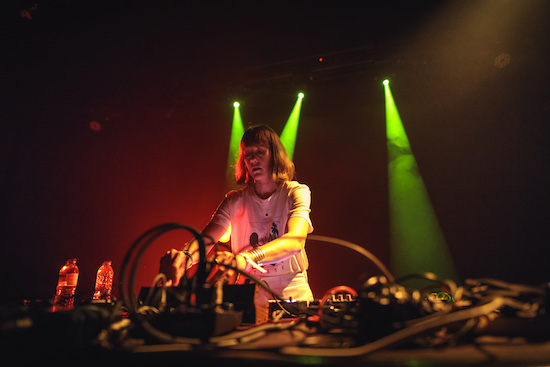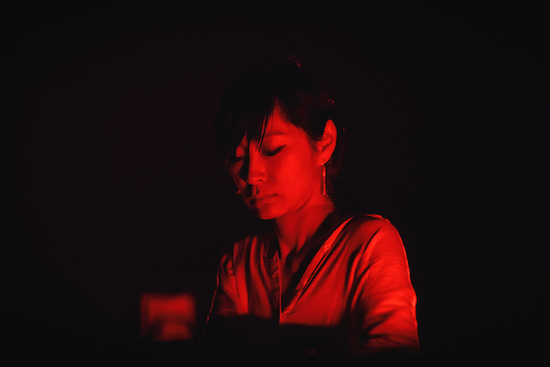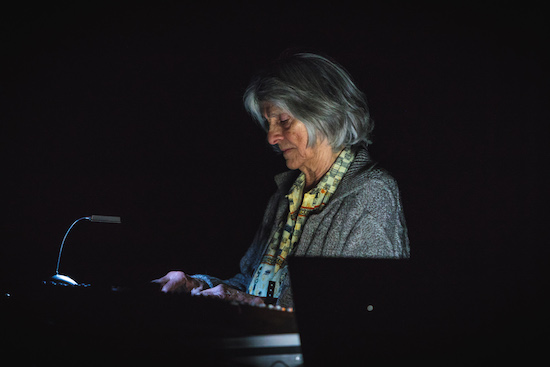Beatriz Ferreyra
Semibreve is a festival carefully built on foundations of space and clarity
Arriving in the city of Braga in northwest Portugal, there’s a sense of ease and space that starts to course through a visitor’s blood. A small, quiet, university city, Braga is the sort of place you might crave when yearning for headspace and relief from the suffocation of big-city life. Quiet, cobbled streets, open doors and endless outdoor seating, bars and cafes make it a city that – to the idealistic guest at least – lends itself to a gentle pace, a reflective mood and a decluttering of the mind.
Taking a seat in the stunning Theatro Circo, built in 1907, you immediately get the feeling that Semibreve, now in its seventh year, channels those same sentiments of care, ease and clarity in its curation. Even in its name: a semibreve is, by definition, uninterrupted, full, spacious. A tight, neatly assembled line-up for the three-day festival makes it possible to catch every act, take a look at every installation and hear every Q&A without ever feeling rushed or needlessly overwhelmed (well, except for when the music itself demands it).
Given all this, it makes sense that Portland’s hypnotic new age duo Visible Cloaks open proceedings on Friday evening in the high-ceilinged Theatro. Spencer Doran and Ryan Carlile create a pristine Technicolor soundscape seems incongruous and unwieldy at first but soon, like the gears and mechanisms of an intricate apparatus, becomes beautiful and captivating. With the help of mind-altering, immersive visuals from digital artist Brenna Murphy, this set is crisp and vibrant, the digital instrumentation, electronic woodwind and loving gaze to 80s Japanese ambience and global sounds shaping themselves around the dazzling colours and shapes.
Afterwards, the faculties and senses in the body and mind feel re-arranged, polished and replenished. It’s not long though before the shroud and mystery of Wolfgang Voigt’s Gas takes over. Intense minimal techno fills every corner of the Theatro’s giant space. Voigt’s looming figure stands almost perfectly still on stage right, allowing the dense, heavy sounds and visuals do their work. Compared to the variety and sheen of Visual Cloaks, Gas is an overpowering affair. There is a feeling of being trapped in a black lodge-esque world of red, a nightmarish and infinite forest. At times the sound and visuals meander, but the overall impact of Gas is powerful and serves as a sobering reminder that even among tranquillity and calm there can be dread. It makes it all the more poignant to know that in recent weeks the surrounding region has been subject to wildfires that have left homes destroyed and at least 32 people dead. With that, the glimmers of hope that find their way into the performance feel all the more touching, all the more necessary.
Beatriz Ferreyra asserts her place as a true legend of experimental sound design
With one of the most engaging and brain-zapping performances of the weekend, Argentine composer Beatriz Ferreyra demonstrates absolute mastery of sonic manipulation. Armed with a sound desk and a 360-degree, room-filling speaker system, the 80-year-old pioneer of experimental music plays three pieces that weave and dance through the small auditorium downstairs in the Theatro Circo. The sporadic, multi-vocal second piece revived from 1978 seizes its audiences in the same way a familiar voice in a din of strangers might. The piece ends abruptly with a titter of laughter, after which a playful smirk can be seen forming on Ferreyra’s lips.
The GNRATION venue is a home for any sensory trip your heart desires
From its angular, trippy skate park smoking area to its myriad spaces for installations and performances, GNRATION’s role in the weekend’s proceedings is key. Gil Delindro and Adam Basanta’s ‘Permafrost’ installation is enticing and strange, with chunks of frozen earth hung above sensors that, when met with falling dirt, create unnerving sounds giving a sense of time’s delicate but definite impact. Meanwhile Nerea Castro’s ‘In Praise of Shadows’ is an installation inspired by a 1933 essay by Japanese writer Jun’ichirō Tanizaki, and explores the power of light, haze, distortion, darkness and humans’ engagement with it.
Performances in the venue’s club space by the inimitable Rabih Beaini and his chilling, metallic improvisation, Berlin-based Japanese musician Kyoka, and Karen Gwyer bring shedloads of energy and hectic pulse to a festival that pays less mind than many to the requirement of a dancefloor. That said, newly formed duo Sabre fail to hit the mark with the venues closing set on Sunday with the movements of their dark, acid drenched techno never becoming fully realised.

Karen Gwyer
Karen Gwyer is a master of acceleration
After a dizzying, electric and brutally abstract set from Kyoka, the closing performance on Friday night from Berlin-based, Ann Arbor-born Karen Gwyer is a propulsive 90 minutes of hardware electronics. With cuts taken from this year’s Rembo making up a fair chunk of the first section, the lunging textures, low-end synths and racing hi-hats spiral more and more into uncharted territory. The club seems a little sedate at first but with each passing moment and with each notching-up of pace, Gwyer seizes more of the crowd. Before long, dancers are lured into a frenzy. The most enjoyable and danceable set of the weekend by a country mile, it’s only a shame that she didn’t play every night.
Steve Hauschildt turns one of Braga’s many churches into a blissful auditorium
Surrounded by lowhanging bulbs in the middle of the Capela Imaculada Do Seminário Menor, a hugely spacious church with an almost brutalist interior, the serene Cleveland-based ambient electronic composer crafts a set that brings the aforementioned clarity and purity right back. A free concert held late on Saturday afternoon, the church is filled with attendants of all ages, from devoted festivalgoers to curious locals and families. Most sit utterly transfixed by the gorgeous, glimmering arpeggiated synths, the warm bass and enchanting distant sounds of birdsong and running water. Plenty of kids look utterly bored, glued to games of their phones or nodding off to sleep on their seats. But then, that is really how a child should feel in a building like this. Blissful music and spiritual devotion – whatever! To have that honest feeling of community, an unpretentious and absolutely open feeling of welcoming and festivity, soundtracked by cuts from Hauschildt’s stunning 2016 album Strands, is one of the weekend’s most touching and resonant moments. It’s impossible to not feel at peace in a setting like this, with sounds like these, surrounded by people who each carry their own unique, beautiful curiosity.

Kyoka
Fis and Deathprod mould imposing tension to dramatic peaks
It’s hard to imagine where the music of New Zealander Oliver Peryman aka Fis would be more perfect. Such a physical, dramatic and awe-inspiring assault on the senses requires, or is at least enriched infinitely, by a space like the Theatro Circo. Accompanied by visual artist Jovan Vucinic, the performance seems a true representation of the capacity of sound and vision to be pushed to their most sublime limits, creating something hallucinatory and, at times, absolutely terrifying.
Sights of black waves crashing, an ultra hi-res flower with a fly resting on it and incomprehensible shapes colliding and collapsing into one another accompany the soundscapes. Bone-shattering jolts of sub-bass, tense distorted fuzz and explosions of scrapes and whistles are at points as overwhelming as a psychedelic trip’s peak, and are just as cathartic. Rewarding, nearly.
Chaotic, haunting and merciless, with incomprehensible ominous sounds of chattering children adding to the set’s unnerving nature, this is not for the faint of heart. But listening to Peryman during his Q&A with Rabih Beaini the next day, his gentleness and humour suggest there’s ultimately something playful and therapeutic about it. Amid the chaos there is openness and faith: the suggestion of hope in darkness and a genuine good intention. And this is the same man who recently launched Saplings, a record label that plants a tree for every sale of a physical release.
These ideas even trickle into the set that follows, by Norwegian ambient stalwart Deathprod, whose infinitely more minimal approach to the genre is accentuated by the constant billows of smoke that fill the room. Deathprod creates an unnerving dissonance that leads the listener to dark places. Here too, though, there is by the end a feeling that even amid such darkness there is a potential for escape. A long flickering strobe and a low low bass drone close the set, leaving us to consider some imagined internal or external abyss and what an awareness of it may mean.
Lawrence English explores physicality, solidarity and the shared experience of sound
An awareness of the darkness, the facing of it, the understanding and shared resolution against it: in many ways this is what defines Lawrence English’s remarkable albumCruel Optimism. Inviting the 15 assorted strangers who took part in his Saturday morning listening workshop to lie on the stage and beckoning the rest of us to sit as close as possible, there is a sort of intimacy achieved despite the Theatro Circo’s size. The set itself is one of the loudest, most intensely physical sonic experiences imaginable. Not a million miles from a Sunn O))) set in its all-encompassing force, it sets chests tight and teeth rattling with its onslaught of bass drones and distortion. On the drop there is a communal exhale, accompanied by a slowly repeated bleep through the smoke of the hall.
In his interview with The Quietus in January of this year, where he discussed the album, English said: "Once you drill down through that I think there’s so much light, or at least the chance for it to erupt and illuminate the dark. " And really, it is that message of light, solidarity and hope that breaks through in this performance. In his impassioned introduction to the set he lays it all out, saying how these ideas have in many ways defined this entire weekend for him. He speaks of the value of community, of bringing people with a shared of love music together and creating an invaluable experience, and he rouses the audience to applaud that solidarity. It’s hard not get a little caught up in the very thought of it: given the setting, given the welcoming atmosphere of the city and its venues, given the varying ages, backgrounds and interests of those present. That solidarity he speaks of seems to spread far beyond the festival.
And perhaps somewhere in there lies the power of the music on display at Semibreve: its potential for any interpretation you like, its potential to connect with all your emotions, faculties and philosophies. What this neat, expertly curated festival seems to do is cleanse the palate and wipe the slate so that these sounds can nestle into your body and help you to thrive.
The closing performance comes from Icelandic Bedroom Community linchpin Valgeir Sigurðsson and his accompanying cellist. As they course through a wide selection of vignettes, from the chaotic and clamorous to the brittle and emotive, it starts to feel as though each one of these openended and distilled sections could mean something distinct to anyone in this room, but that ultimately there is unity and togetherness in the shared joy of it. With luck, Semibreve will keep returning so that more and more can experience that very feeling: that sense of openness and clarity, and the unity that comes with it.
All photos by Adriano Ferreira Borges


